Слайд 2
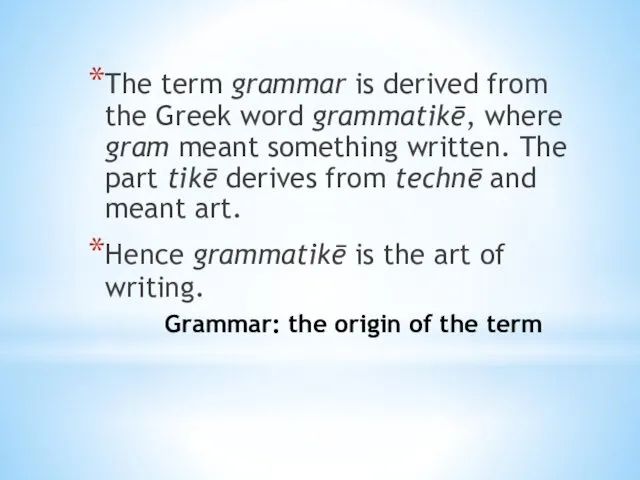
Grammar: the origin of the term
The term grammar is derived from
the Greek word grammatikē, where gram meant something written. The part tikē derives from technē and meant art.
Hence grammatikē is the art of writing.
Слайд 3
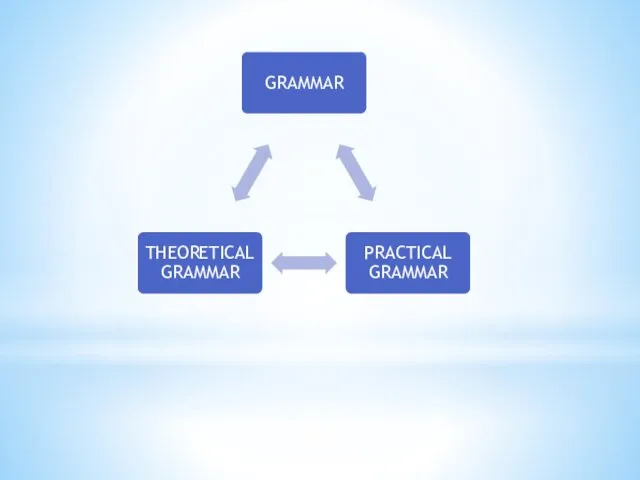
Слайд 4
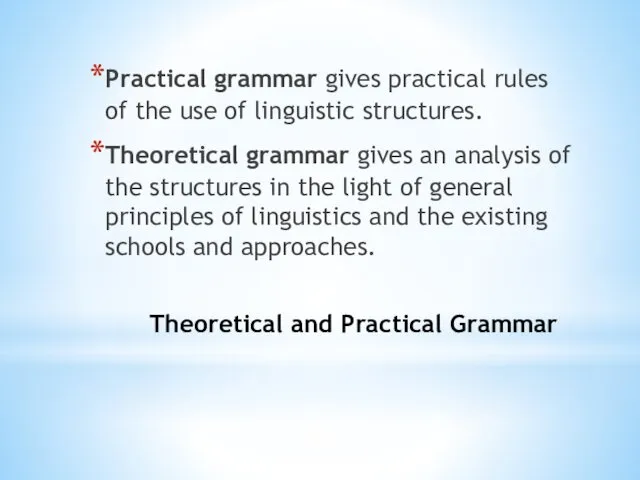
Theoretical and Practical Grammar
Practical grammar gives practical rules of the use
of linguistic structures.
Theoretical grammar gives an analysis of the structures in the light of general principles of linguistics and the existing schools and approaches.
Слайд 5
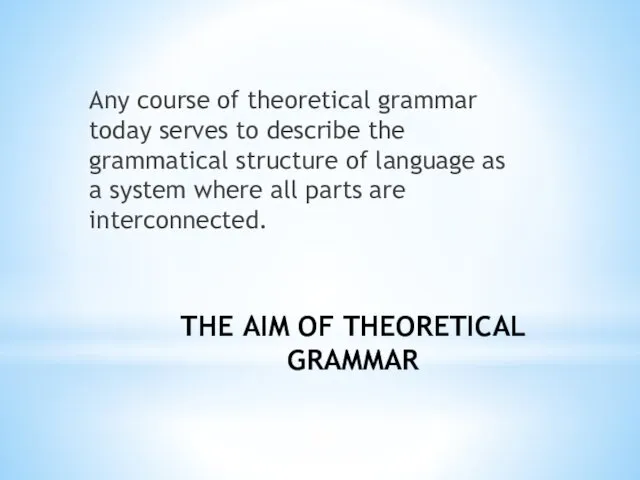
THE AIM OF THEORETICAL GRAMMAR
Any course of theoretical grammar today serves
to describe the grammatical structure of language as a system where all parts are interconnected.
Слайд 6
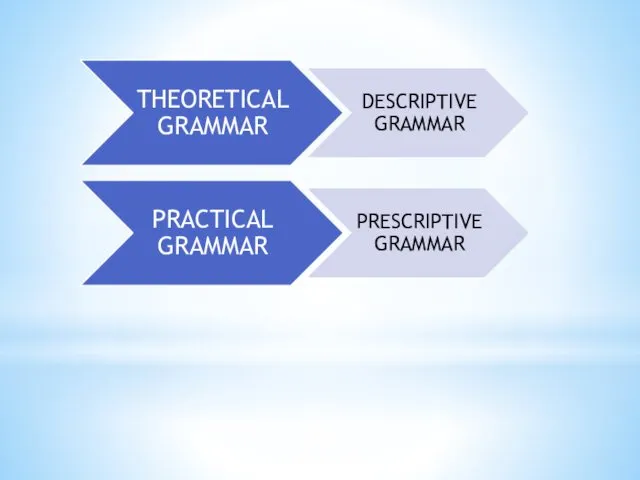
Слайд 7

Prescriptive and Descriptive Grammar
Practical grammar prescribes certain rules of usage and
teaches to speak or write correctly.
Theoretical grammar presents facts of language while analyzing them and gives no prescriptions.
To a prescriptive grammarian, grammar is rules of correct usage; its aim is to prescribe what is judged to be correct rather than to describe actual usage.
To a descriptive grammarian (descriptivist), grammar is a systematic description of the structure of a language.
Слайд 8

Historical Types of Grammars
Слайд 9
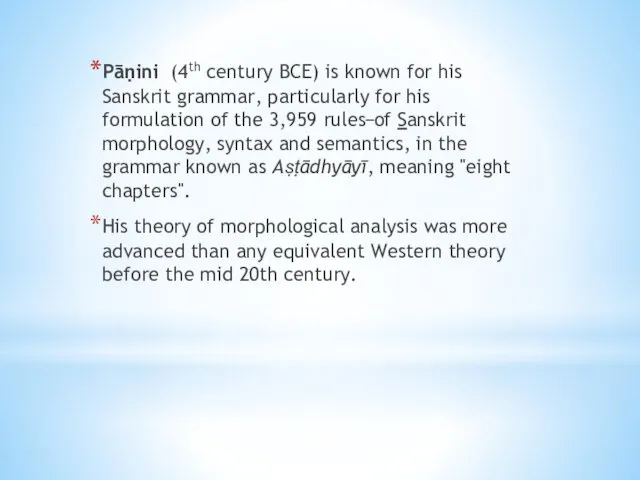
Pāṇini (4th century BCE) is known for his Sanskrit grammar, particularly
for his formulation of the 3,959 rules of Sanskrit morphology, syntax and semantics, in the grammar known as Aṣṭādhyāyī, meaning "eight chapters".
His theory of morphological analysis was more advanced than any equivalent Western theory before the mid 20th century.
Слайд 10
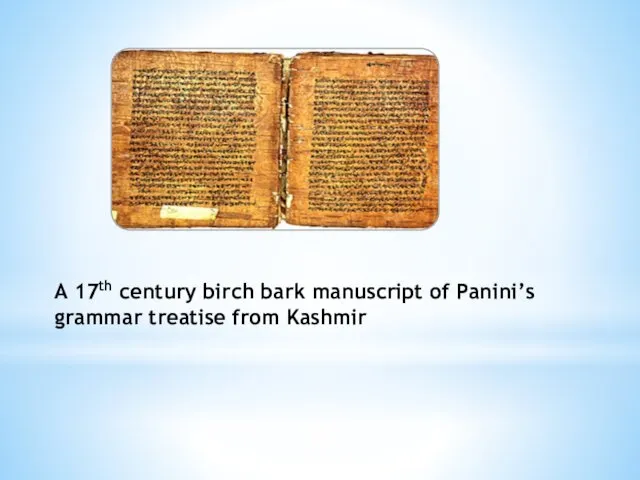
A 17th century birch bark manuscript of Panini’s grammar treatise from
Kashmir
Слайд 11
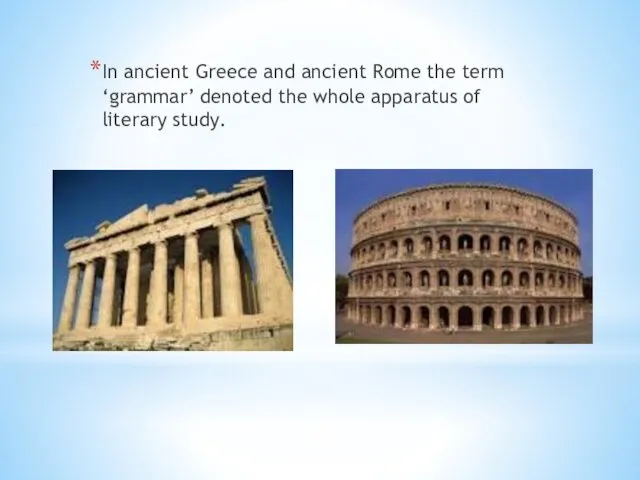
In ancient Greece and ancient Rome the term ‘grammar’ denoted the
whole apparatus of literary study.
Слайд 12
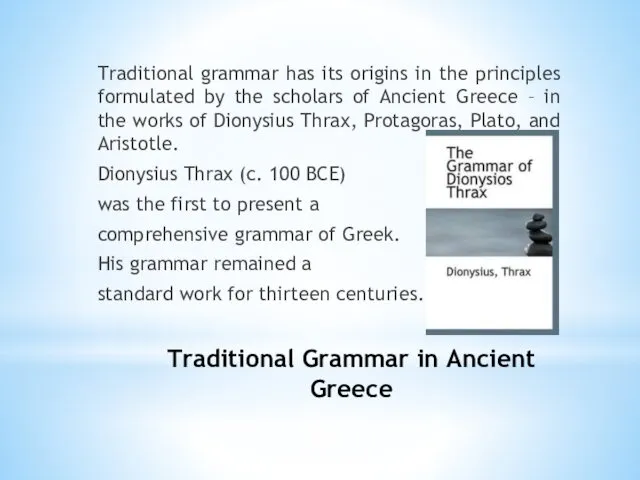
Traditional Grammar in Ancient Greece
Traditional grammar has its origins in the
principles formulated by the scholars of Ancient Greece – in the works of Dionysius Thrax, Protagoras, Plato, and Aristotle.
Dionysius Thrax (c. 100 BCE)
was the first to present a
comprehensive grammar of Greek.
His grammar remained a
standard work for thirteen centuries.
Слайд 13
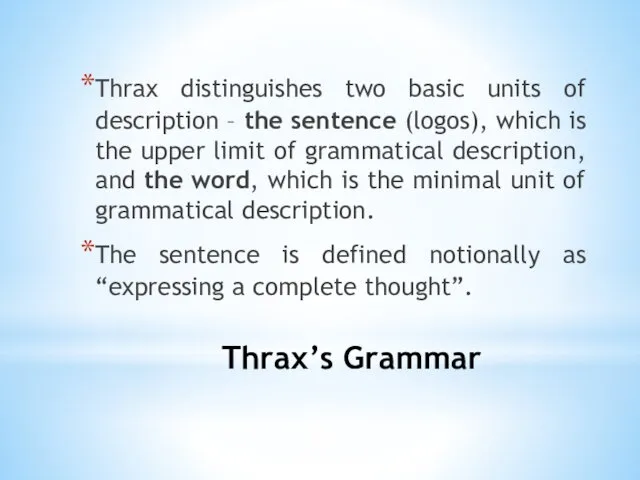
Thrax’s Grammar
Thrax distinguishes two basic units of description – the sentence
(logos), which is the upper limit of grammatical description, and the word, which is the minimal unit of grammatical description.
The sentence is defined notionally as “expressing a complete thought”.
Слайд 14
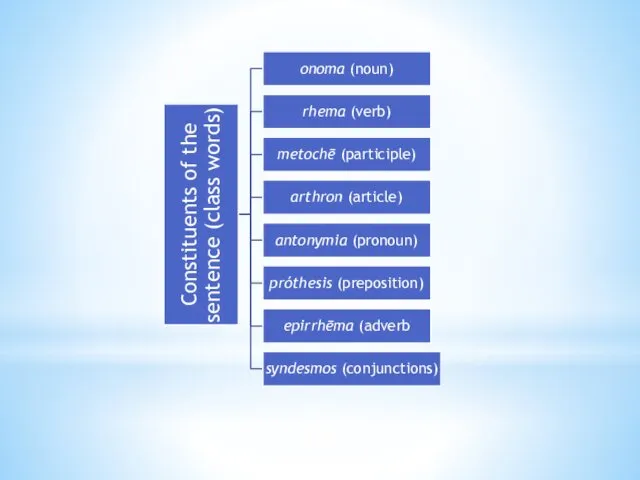
Слайд 15

Traditional Grammar in Ancient Rome
The first Latin grammar was written by
Varro (116–27 B.C.). One of Varro’s merits is the distinction between derivation and inflection. Varro set up the following system of four inflexionally contrasting classes:
1) those with case inflexion (nouns
including adjectives);
2) those with tense inflexion (verbs);
3) those with case and tense inflexion
(participles);
4) those with neither (adverb).
Слайд 16
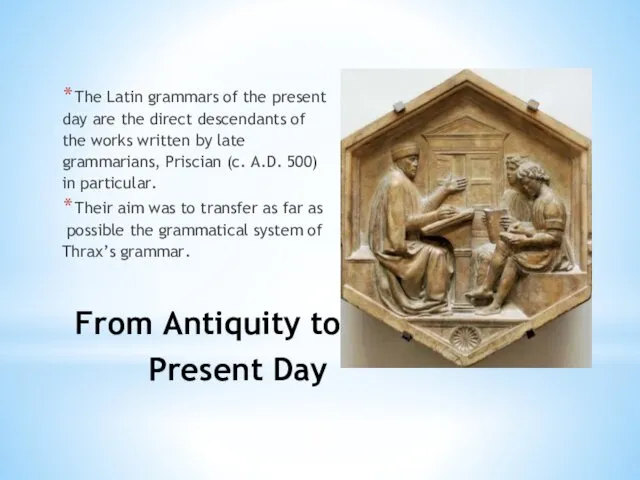
From Antiquity to the Present Day
The Latin grammars of the
present
day are the direct descendants of
the works written by late
grammarians, Priscian (c. A.D. 500)
in particular.
Their aim was to transfer as far as
possible the grammatical system of
Thrax’s grammar.
Слайд 17
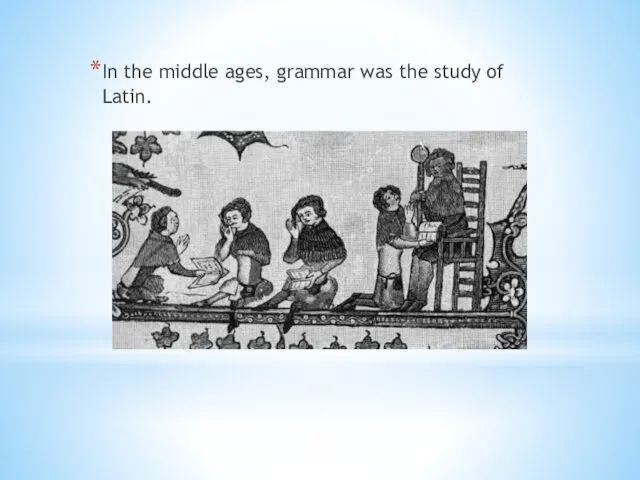
In the middle ages, grammar was the study of Latin.
Слайд 18
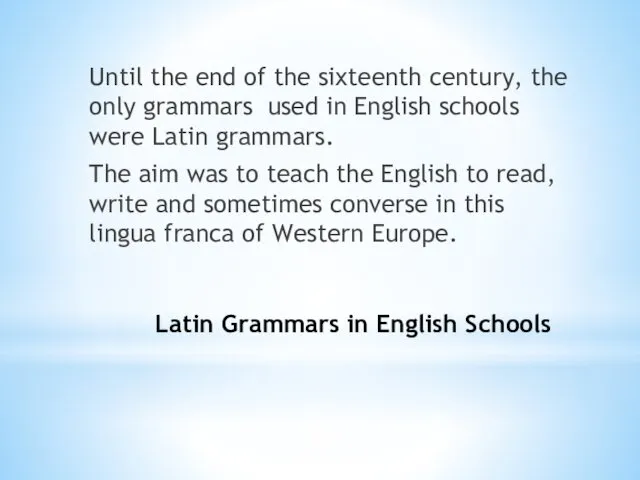
Latin Grammars in English Schools
Until the end of the sixteenth century,
the only grammars used in English schools were Latin grammars.
The aim was to teach the English to read, write and sometimes converse in this lingua franca of Western Europe.
Слайд 19
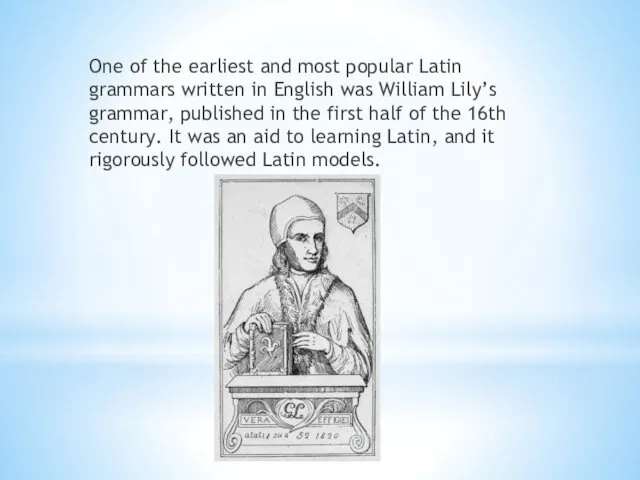
One of the earliest and most popular Latin grammars written in
English was William Lily’s grammar, published in the first half of the 16th century. It was an aid to learning Latin, and it rigorously followed Latin models.
Слайд 20
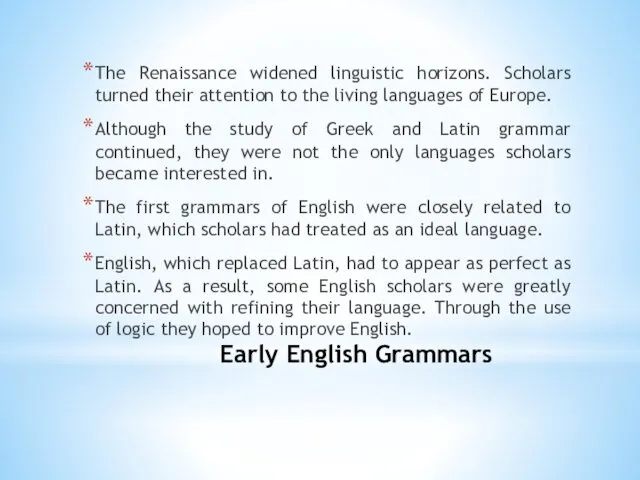
Early English Grammars
The Renaissance widened linguistic horizons. Scholars turned their attention
to the living languages of Europe.
Although the study of Greek and Latin grammar continued, they were not the only languages scholars became interested in.
The first grammars of English were closely related to Latin, which scholars had treated as an ideal language.
English, which replaced Latin, had to appear as perfect as Latin. As a result, some English scholars were greatly concerned with refining their language. Through the use of logic they hoped to improve English.
Слайд 21
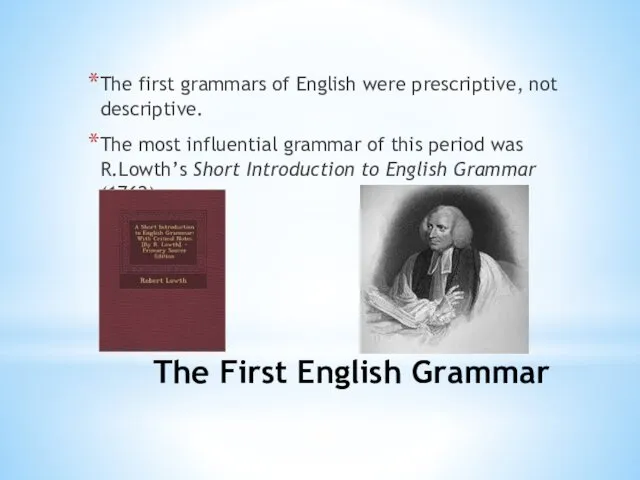
The First English Grammar
The first grammars of English were prescriptive,
not descriptive.
The most influential grammar of this period was R.Lowth’s Short Introduction to English Grammar (1762).
Слайд 22
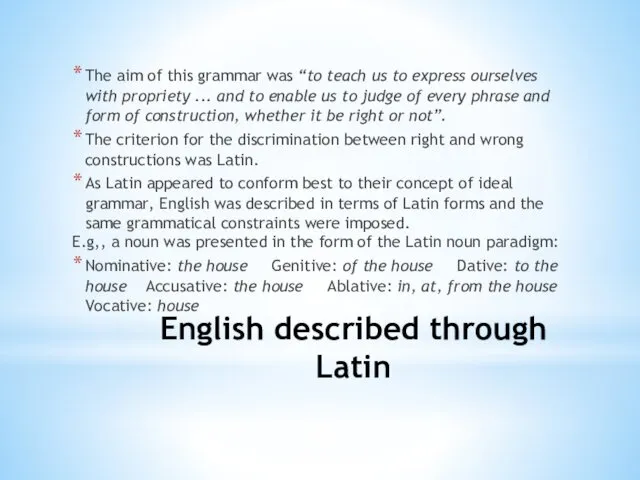
English described through Latin
The aim of this grammar was “to teach
us to express ourselves with propriety ... and to enable us to judge of every phrase and form of construction, whether it be right or not”.
The criterion for the discrimination between right and wrong constructions was Latin.
As Latin appeared to conform best to their concept of ideal grammar, English was described in terms of Latin forms and the same grammatical constraints were imposed.
E.g,, a noun was presented in the form of the Latin noun paradigm:
Nominative: the house Genitive: of the house Dative: to the house Accusative: the house Ablative: in, at, from the house Vocative: house
Слайд 23
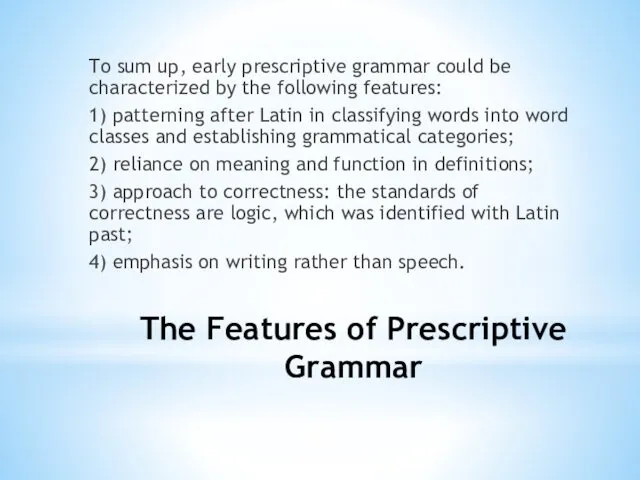
The Features of Prescriptive Grammar
To sum up, early prescriptive grammar
could be characterized by the following features:
1) patterning after Latin in classifying words into word classes and establishing grammatical categories;
2) reliance on meaning and function in definitions;
3) approach to correctness: the standards of correctness are logic, which was identified with Latin past;
4) emphasis on writing rather than speech.
Слайд 24
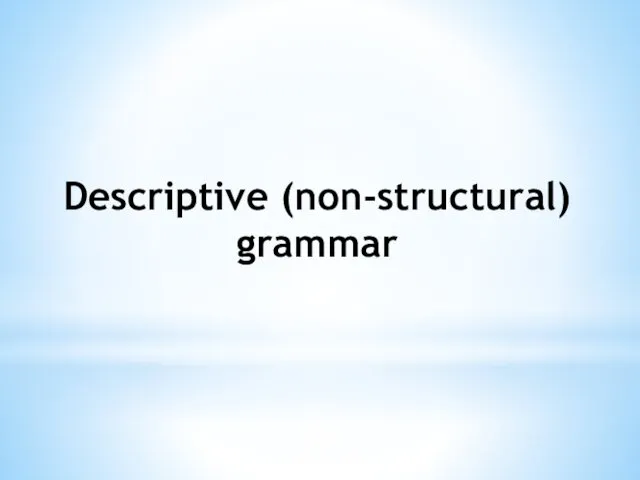
Descriptive (non-structural) grammar
Слайд 25
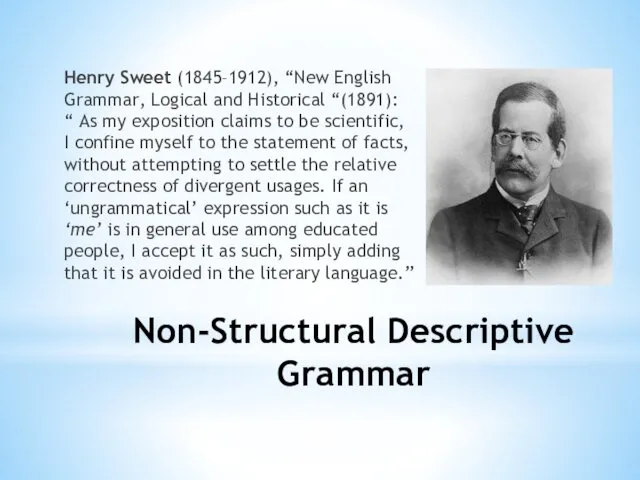
Non-Structural Descriptive Grammar
Henry Sweet (1845–1912), “New English
Grammar, Logical and
Historical “(1891):
“ As my exposition claims to be scientific,
I confine myself to the statement of facts, without attempting to settle the relative correctness of divergent usages. If an ‘ungrammatical’ expression such as it is ‘me’ is in general use among educated people, I accept it as such, simply adding that it is avoided in the literary language.”
Слайд 26

Non-Structural Descriptive Grammar in Summary
Unlike prescriptivists, descriptivists focus their attention on
actual usage without trying “to settle the relative correctness of divergent usages.”
Similar to prescriptivists, descriptivists use meaning and function in their definition of parts of speech.
Слайд 27
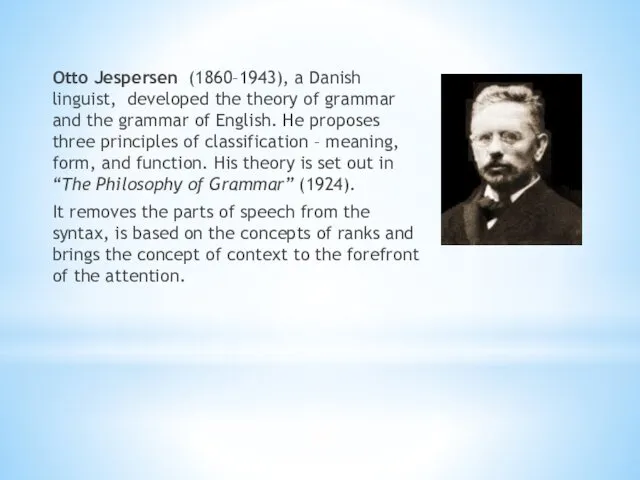
Otto Jespersen (1860–1943), a Danish linguist, developed the theory of grammar
and the grammar of English. He proposes three principles of classification – meaning, form, and function. His theory is set out in “The Philosophy of Grammar” (1924).
It removes the parts of speech from the syntax, is based on the concepts of ranks and brings the concept of context to the forefront of the attention.
Слайд 28

The Emergence of Structuralism
Слайд 29
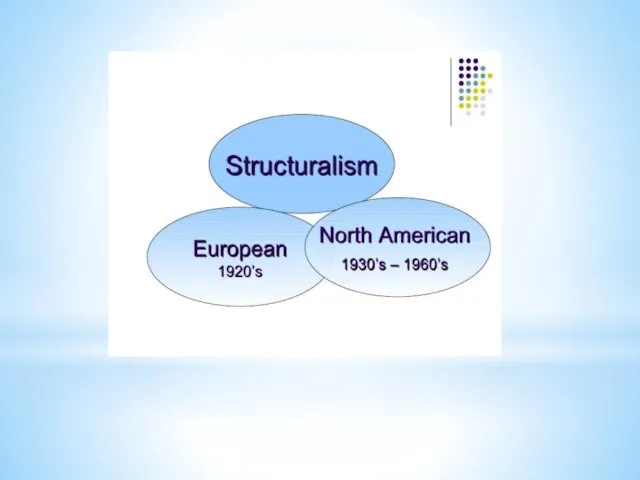
Слайд 30
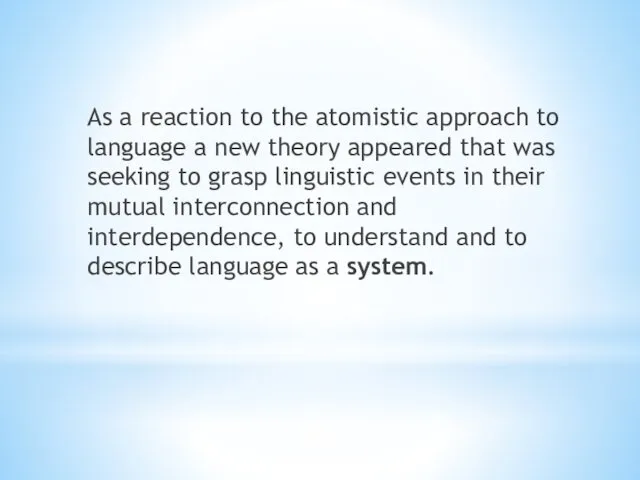
As a reaction to the atomistic approach to language a new
theory appeared that was seeking to grasp linguistic events in their mutual interconnection and interdependence, to understand and to describe language as a system.
Слайд 31

The first linguists to speak of language as a system or
a structure of smaller systems were Beaudouin de Courtenay (1845-1929) and F.F.Fortunatov (1848-1914) of Russia, and the Swiss linguist Ferdinand de Saussure (1857-1913).
Слайд 32
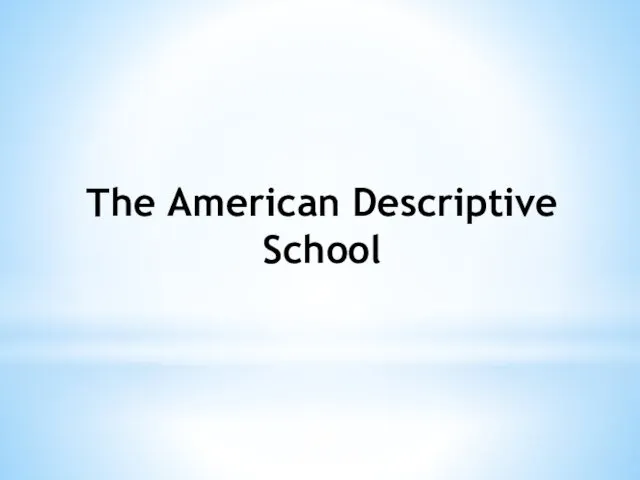
The American Descriptive School
Слайд 33

Frantz Boas, linguist and anthropologist (1858-1942) is usually mentioned as the
predecessor of American Descriptivism.
His basic ideas were later developed by Edward Sapir (1884-1939) and Leonard Bloomfield (1887-1949).
Слайд 34
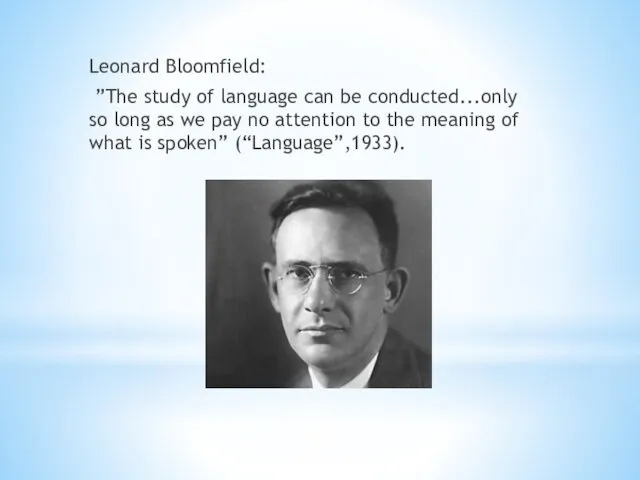
Leonard Bloomfield:
”The study of language can be conducted...only so long
as we pay no attention to the meaning of what is spoken” (“Language”,1933).
Слайд 35
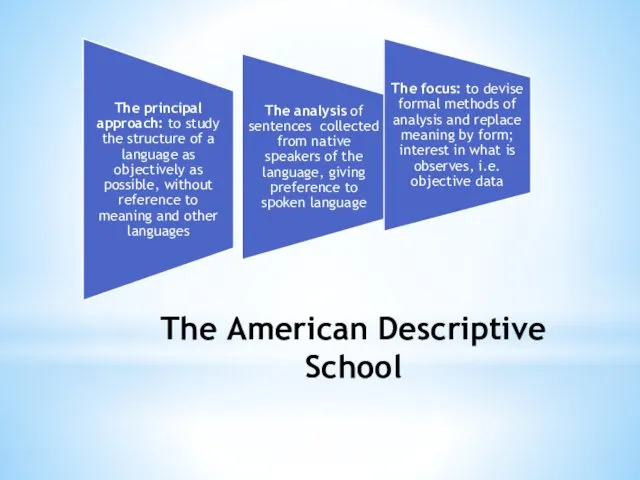
The American Descriptive School
Слайд 36
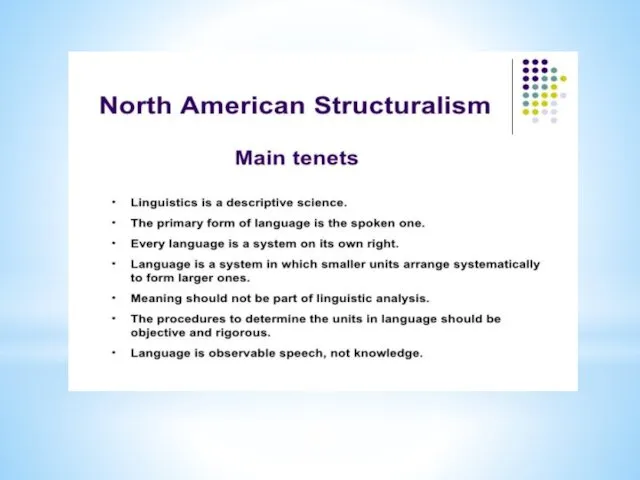
Слайд 37
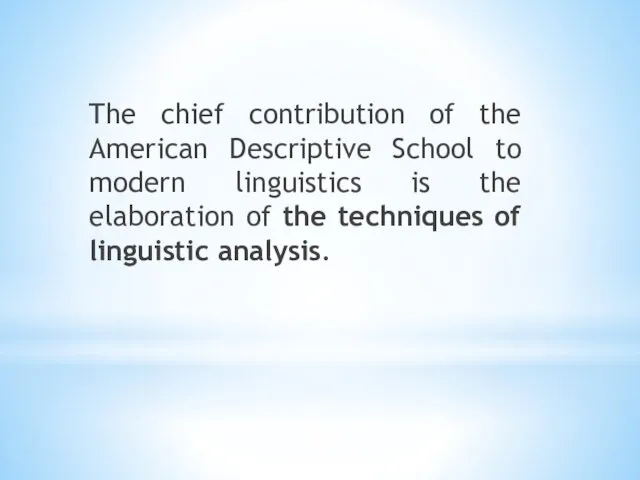
The chief contribution of the American Descriptive School to modern linguistics
is the elaboration of the techniques of linguistic analysis.
Слайд 38
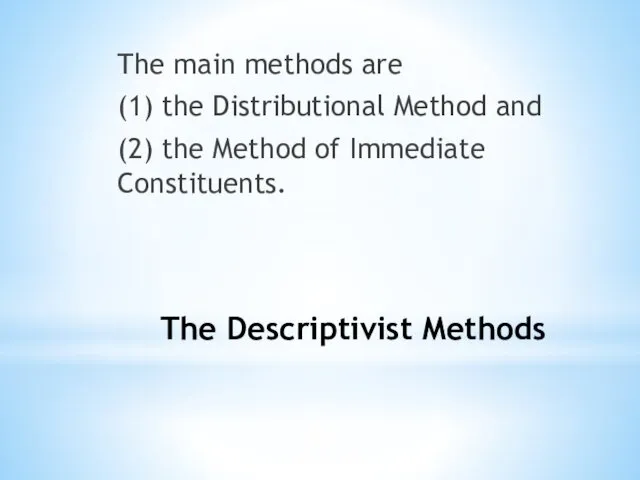
The Descriptivist Methods
The main methods are
(1) the Distributional Method and
(2) the Method of Immediate Constituents.
Слайд 39
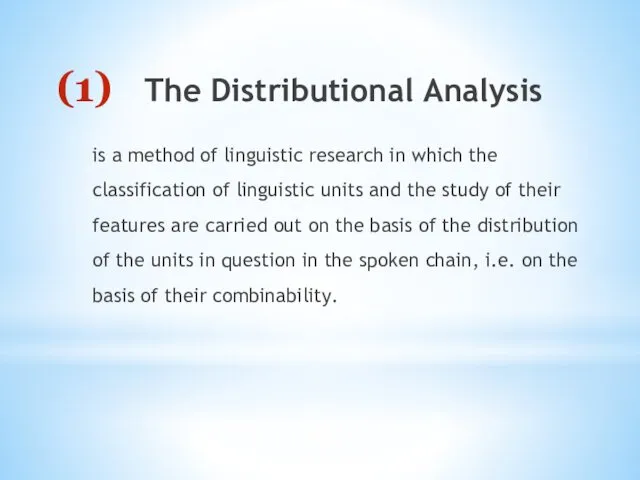
The Distributional Analysis
is a method of linguistic research in which
the classification of linguistic units and the study of their features are carried out on the basis of the distribution of the units in question in the spoken chain, i.e. on the basis of their combinability.
Слайд 40
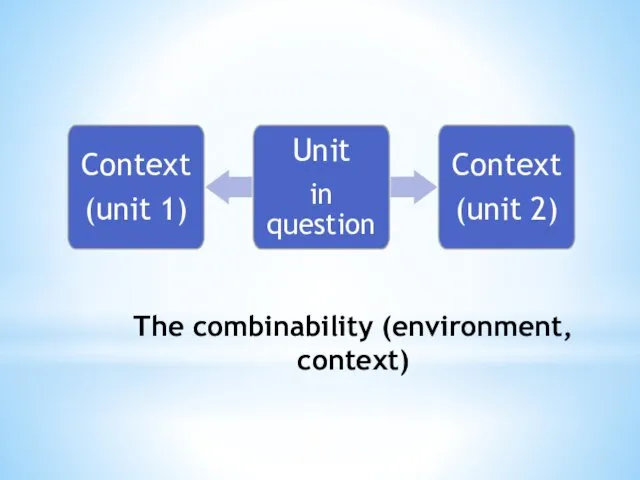
The combinability (environment, context)
Слайд 41
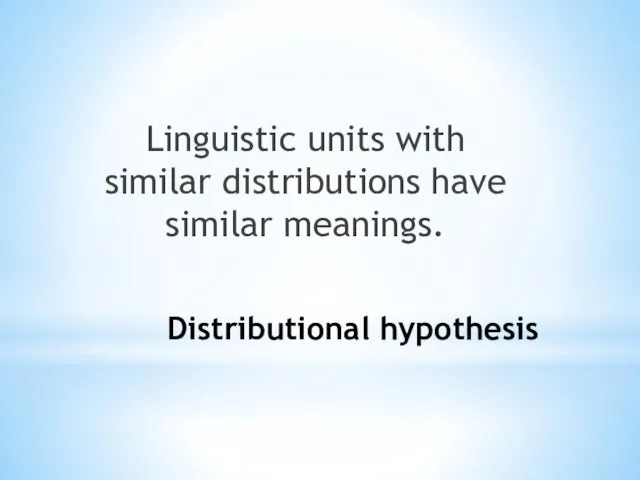
Distributional hypothesis
Linguistic units with similar distributions have similar meanings.
Слайд 42
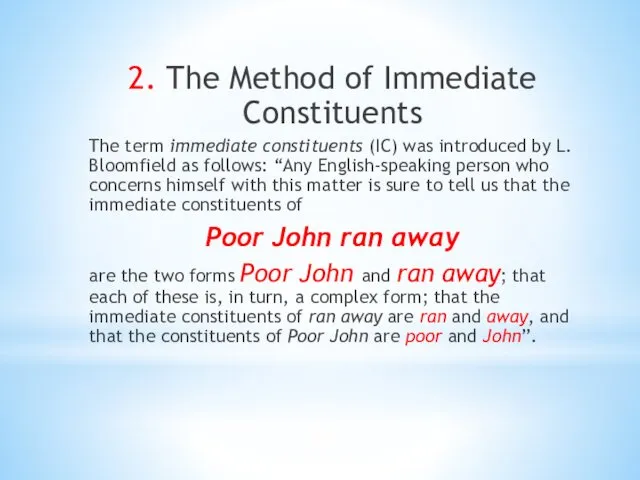
2. The Method of Immediate Constituents
The term immediate constituents (IC) was
introduced by L. Bloomfield as follows: “Any English-speaking person who concerns himself with this matter is sure to tell us that the immediate constituents of
Poor John ran away
are the two forms Poor John and ran away; that each of these is, in turn, a complex form; that the immediate constituents of ran away are ran and away, and that the constituents of Poor John are poor and John”.
Слайд 43
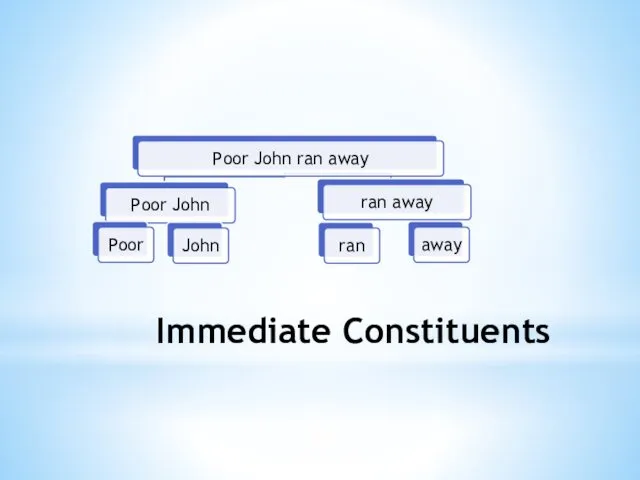
Слайд 44
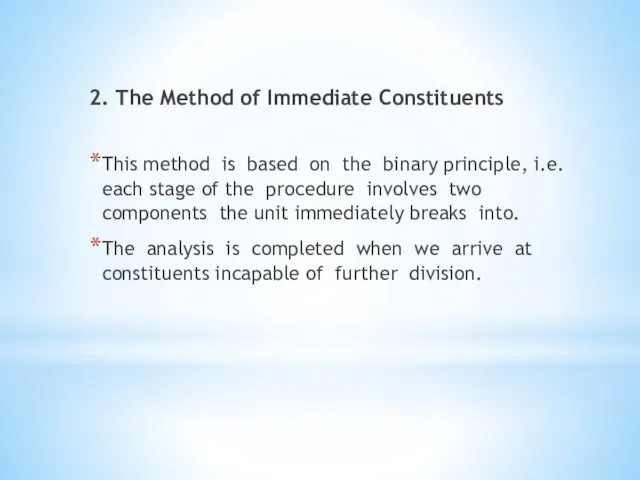
2. The Method of Immediate Constituents
This method is based on the
binary principle, i.e. each stage of the procedure involves two components the unit immediately breaks into.
The analysis is completed when we arrive at constituents incapable of further division.
Слайд 45

DEFINITIONS for the Method of Immediate Constituents
Слайд 46
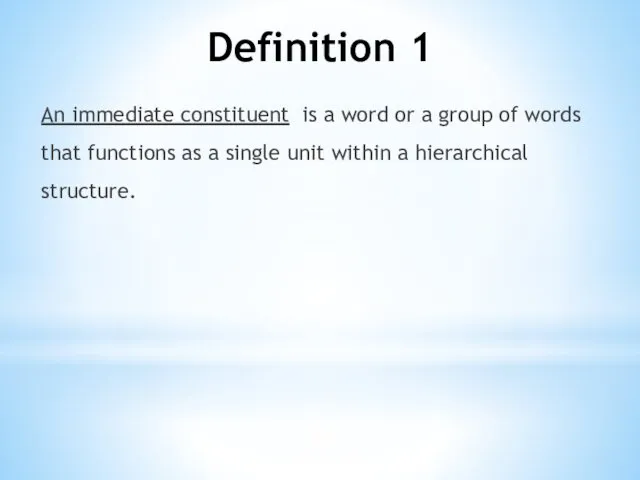
Definition 1
An immediate constituent is a word or a group of
words that functions as a single unit within a hierarchical structure.
Слайд 47
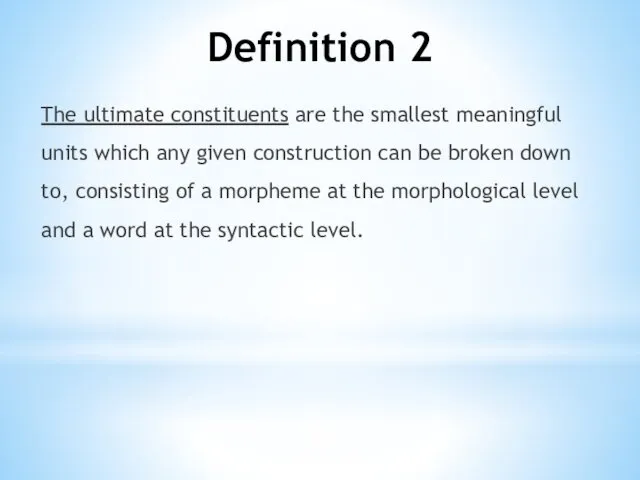
Definition 2
The ultimate constituents are the smallest meaningful units which any
given construction can be broken down to, consisting of a morpheme at the morphological level and a word at the syntactic level.
Слайд 48
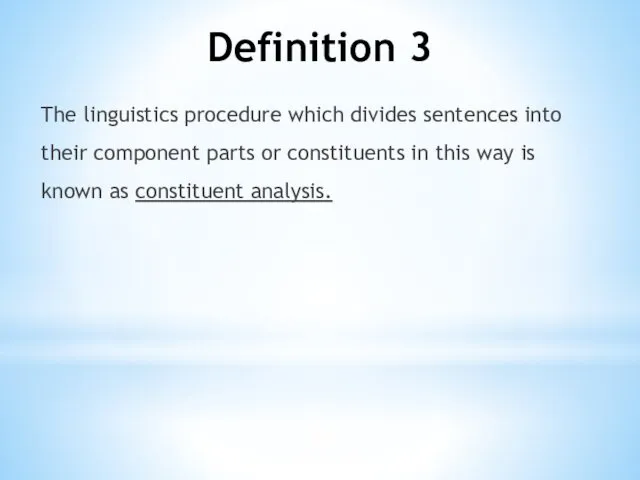
Definition 3
The linguistics procedure which divides sentences into their component parts
or constituents in this way is known as constituent analysis.
Слайд 49

Definition 4
The segmentation of the sentence into its immediate constituents by
using binary cuttings until its ultimate constituents are obtained is called Immediate Constituent Analysis (IC Analysis).
Слайд 50
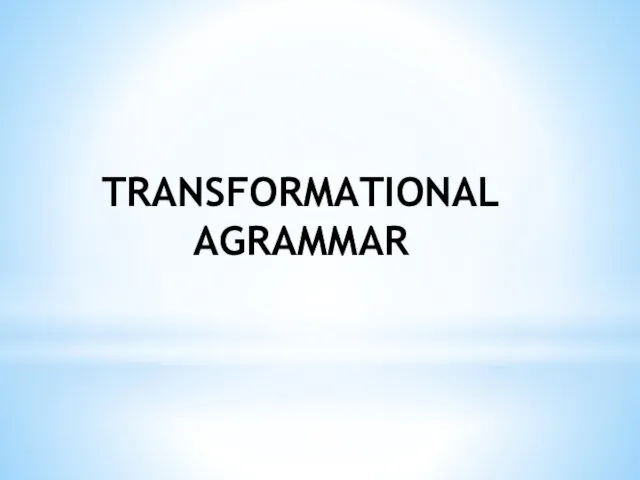
TRANSFORMATIONAL AGRAMMAR
Слайд 51
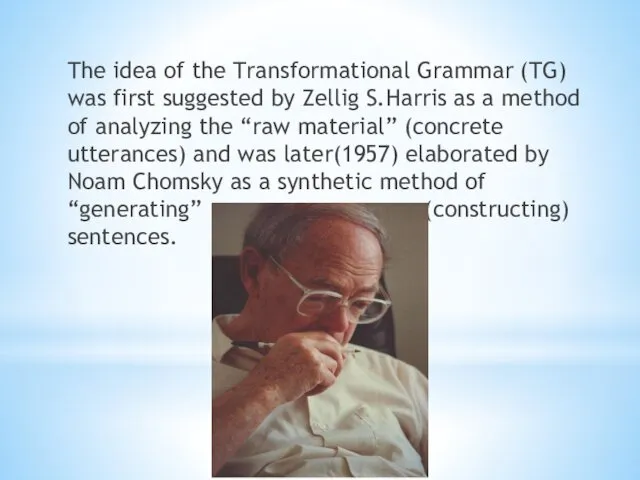
The idea of the Transformational Grammar (TG) was first suggested by
Zellig S.Harris as a method of analyzing the “raw material” (concrete utterances) and was later(1957) elaborated by Noam Chomsky as a synthetic method of “generating” (constructing) sentences.
Слайд 52
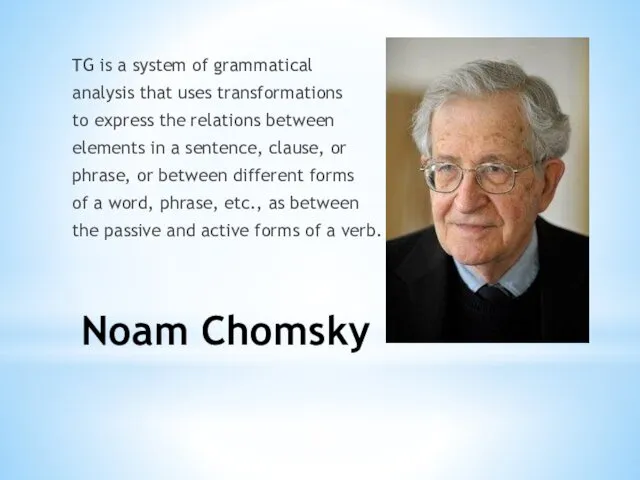
Noam Chomsky
TG is a system of grammatical
analysis that uses transformations
to express the relations between
elements in a sentence, clause, or
phrase, or between different forms
of a word, phrase, etc., as between
the passive and active forms of a verb.
Слайд 53

TG refers to syntax and presupposes the recognition (identification) of such
linguistic units as phonemes, morphemes and form-classes, the latter being stated according to the distributional and the IC-analysis or otherwise.
Слайд 54
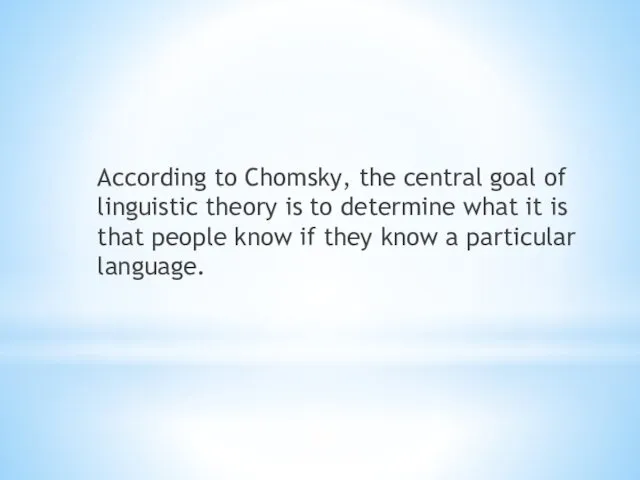
According to Chomsky, the central goal of linguistic theory is to
determine what it is that people know if they know a particular language.
Слайд 55
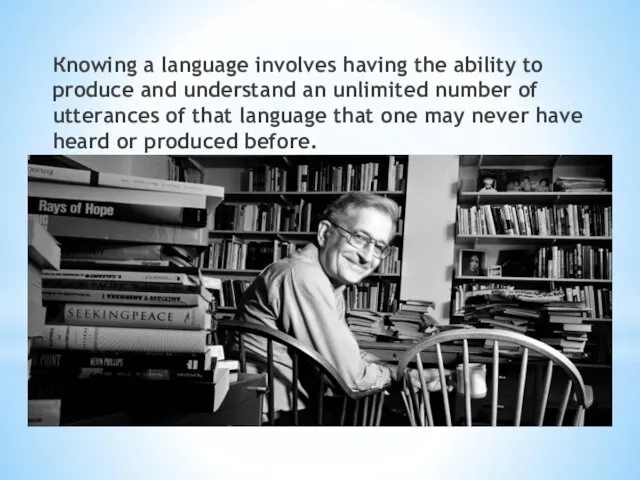
Кnowing a language involves having the ability to produce and understand
an unlimited number of utterances of that language that one may never have heard or produced before.
Слайд 56

А GM is a system of explicit rules that may apply
recursively to generate an indefinite number of sentences that can be as long as you want them to be.
John saw the picture of the baby on the table in the attic.
S-sentence, N-noun, NP-noun phrase, V-verb, VP-verb phrase, P-preposition, PP-prepositional phrase, DP-determiner phrase, DET-determiner.
Слайд 57
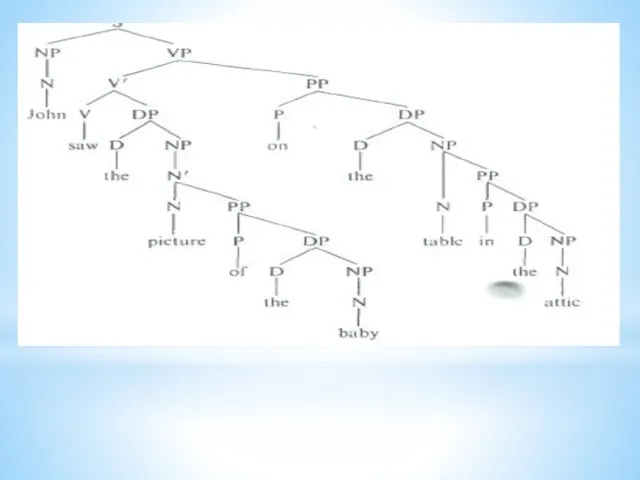
Слайд 58

In generative linguistics 'grammar' refers to the implicit, totally unarticulated knowledge
of rules and principles of the language that people have in their heads.
This tacit knowledge enables them to distinguish between well-formed and ill-formed words and utterances in their language, e.g. it’s correct to say a grain but 'incorrect' to say *a oat.
Слайд 59

In generative linguistics the term 'grammar' covers not only morphology and
syntax but also semantics, the lexicon and phonology.
Phonological rules, morphological rules, syntactic rules and semantic rules are all regarded as rules of grammar.
Слайд 60
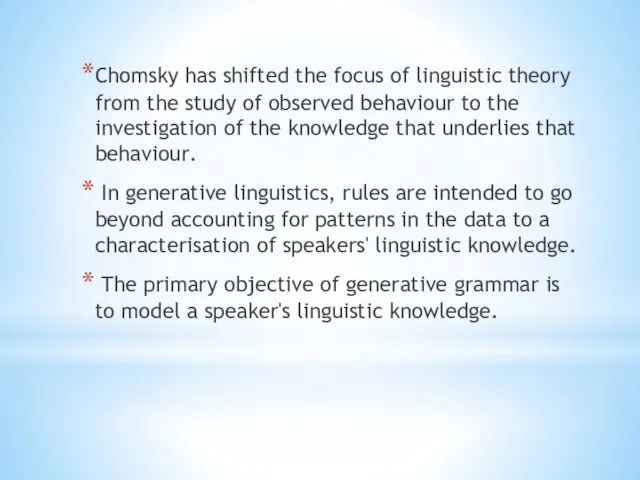
Chomsky has shifted the focus of linguistic theory from the study
of observed behaviour to the investigation of the knowledge that underlies that behaviour.
In generative linguistics, rules are intended to go beyond accounting for patterns in the data to a characterisation of speakers' linguistic knowledge.
The primary objective of generative grammar is to model a speaker's linguistic knowledge.
Слайд 61

Chomsky characterises linguistic knowledge using the concepts of competence and performance.
Слайд 62

Competence is a person's implicit knowledge of the rules of a
language that makes the production and understanding of an indefinitely large number of new utterances possible.
Performance is the actual use of language in real situations.
Слайд 63

Chomsky proposes that competence, rather than performance, is the primary object
of linguistic inquiry.
Слайд 64

Chomsky contends that the linguistic capacity of humans is innate. The
general character of linguistic knowledge is determined by the nature of the mind, which has a specialized language faculty.
This faculty is determined in turn by the biology of the brain. The human child is born with a blueprint of language that is called Universal Grammar.
Слайд 65
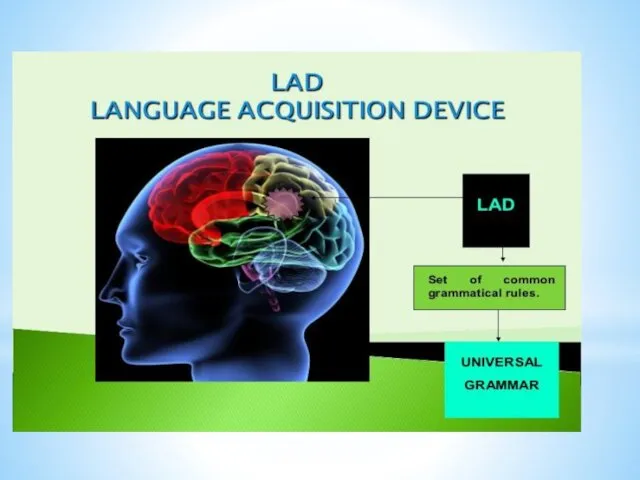
Слайд 66

According to Chomsky, Universal Grammar is the faculty of the mind
that determines the nature of language acquisition in the infant and of linguistic competence.
Слайд 67
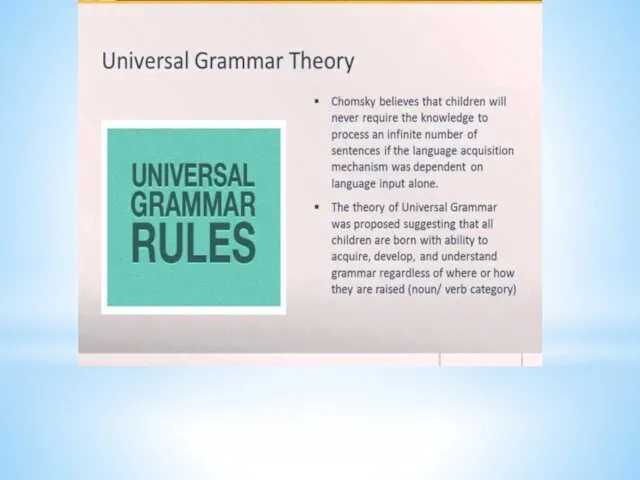
Слайд 68
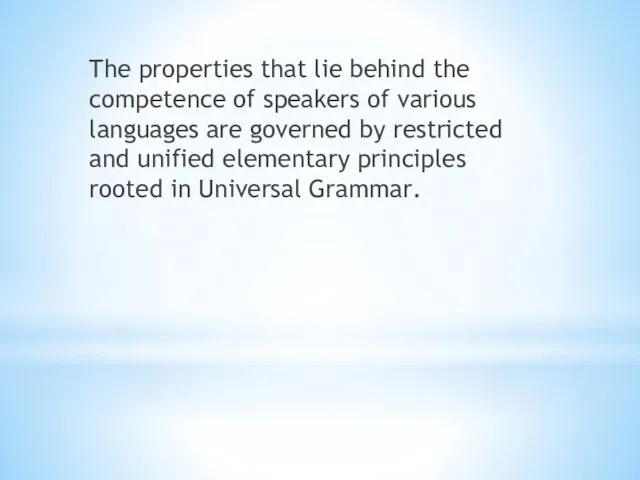
The properties that lie behind the competence of speakers of various
languages are governed by restricted and unified elementary principles rooted in Universal Grammar.
Слайд 69
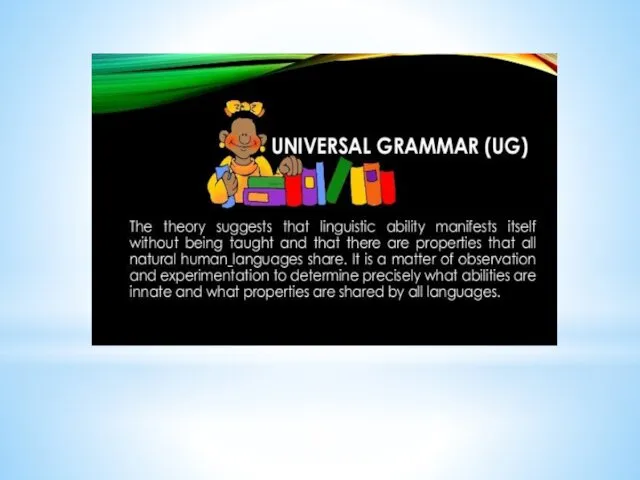
Слайд 70
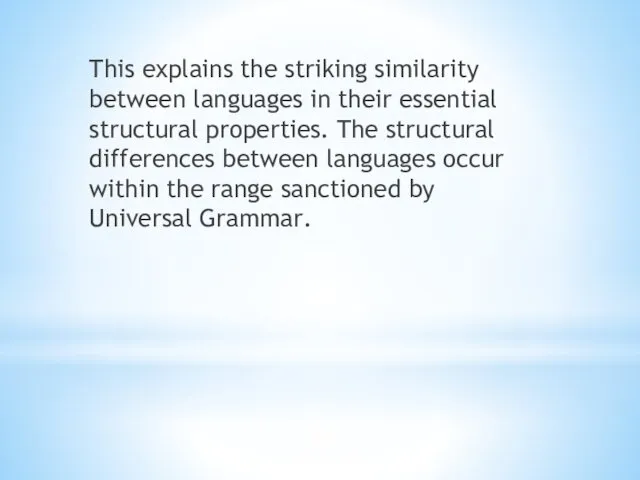
This explains the striking similarity between languages in their essential structural
properties. The structural differences between languages occur within the range sanctioned by Universal Grammar.
Слайд 71
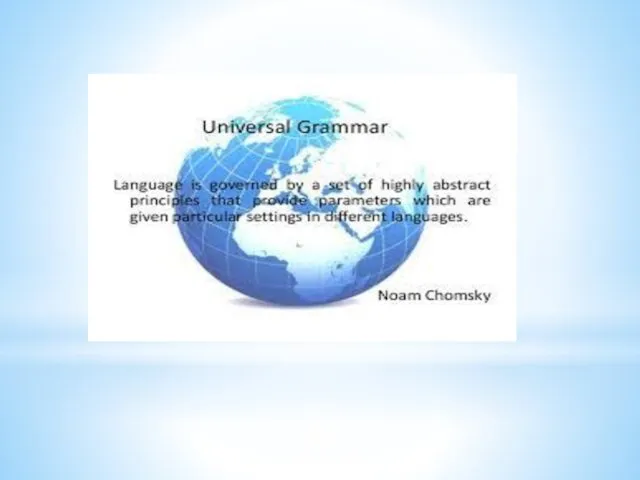
Слайд 72

TEST 1
1. The method based on the binary principle, which breaks
each unit into two components, is called the
distributional analysis
method of immediate constituents
descriptive method
method of structural oppositions
2. Panini wrote one of the first grammars of
Latin
Ancient Greek
Sanskrit
Old Italian
Слайд 73

3-5. Add one word into each gap. The first letter is
given:
Practical grammar (3) p__________ certain rules of usage and teaches to speak or write correctly rather than to describe actual usage. (4) T_____________ grammar presents facts of language while analyzing them and gives no prescriptions. To a (5) d___________ grammarian, grammar is a systematic account of the structure of a language.
Слайд 74

6. Show the chronological order in which the four great grammarians
of the past lived and worked (1 - the earliest one, …, 4 – the latest one):
Varro -
Lily –
Thrax –
Priscian -
Слайд 75

7. Choose as many possible correct answers as necessary: In the
distributional analysis the classification and the study of linguistic units are carried out on the basis of their distribution in the spoken chain, i.e. on the basis of their _______________.
combinability
addition
environment
context
Слайд 76

8. According to Chomsky, the central goal of linguistic theory is
to determine
what the difference between competence is performance is.
what it is that people know if they know a particular language.
how languages differ from one another.
what methods are used in linguistic research.











































































 Reported speech
Reported speech Travel and leisure
Travel and leisure Анализ перевода поэтических произведений с английского языка на русский на примере перевода стихотворений Д. Г. Байрона
Анализ перевода поэтических произведений с английского языка на русский на примере перевода стихотворений Д. Г. Байрона Spotlight 6. Module 9. Food and Refreshments
Spotlight 6. Module 9. Food and Refreshments My favorite shop
My favorite shop Travelling
Travelling Names of the seasons
Names of the seasons English Result. Unit 9
English Result. Unit 9 How I did my research The most dangerous disasters in the Lipetsk region
How I did my research The most dangerous disasters in the Lipetsk region English inscription on clothes
English inscription on clothes Crossword Countries and flags
Crossword Countries and flags Basic concepts and directions of the non-classical and post-nonclassical stage of history and philosophy of science
Basic concepts and directions of the non-classical and post-nonclassical stage of history and philosophy of science The Future Tenses
The Future Tenses Сложное предложение. Часть I
Сложное предложение. Часть I Class room language
Class room language The Menshikov Palace
The Menshikov Palace Parts of speech
Parts of speech УМК Forward. Английский язык 6 класс
УМК Forward. Английский язык 6 класс The Legal Profession in Britain
The Legal Profession in Britain To be 8 in1
To be 8 in1 What do they do?
What do they do? Listening comprehension
Listening comprehension My school
My school Schools in Britain
Schools in Britain Типы словосочетаний в английском и русском языках. Лекция 10
Типы словосочетаний в английском и русском языках. Лекция 10 Describing a process. Tips and strategies
Describing a process. Tips and strategies Personal details. Lesson 7
Personal details. Lesson 7 Youth problems
Youth problems